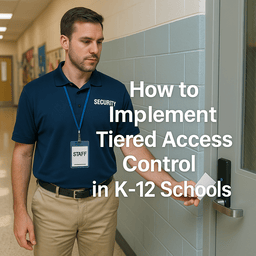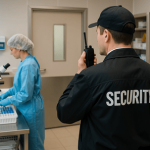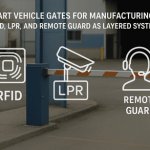
In the modern era of school safety, simply locking the front doors isn’t enough. K–12 campuses are dynamic environments where students, faculty, custodians, parents, visitors, and contractors come and go throughout the day.
Managing who has access to which areas—and when—is critical. That’s where tiered access control comes in.
By structuring campus access based on roles, zones, and time of day, schools can drastically improve safety, streamline operations, and respond faster in emergencies. Best of all, it’s achievable with today’s affordable and scalable school security systems.
k
k
What Is Tiered Access Control?
Tiered access control is a security strategy that assigns different access levels to different users based on their roles and responsibilities.
Instead of giving everyone a master key or universal badge, a tiered approach means:
-
Teachers can access classrooms, lounges, and select entrances.
-
Students can only enter certain doors during certain times.
-
Custodial and maintenance staff access varies by shift and need.
-
Visitors are only granted temporary access to specific zones.
-
Administrators and security personnel have broader or full access.
Think of it like a digital permissions system—but for your physical spaces.
🔐 “Tiered access allows schools to lock down sensitive zones without locking out the people who need them.”
k
k
Why Schools Need Tiered Access Control
✅ 1. Increased Safety Without Inconvenience
Limiting who can go where—and when—reduces the chances of unauthorized access, theft, or harm, without disrupting the daily flow of school life.
✅ 2. Improved Emergency Response
Access logs and user permissions help security teams and first responders:
-
Track who is on campus
-
Identify doors left open or forced
-
Lock down or open specific zones instantly
✅ 3. Better Oversight and Accountability
Digital access logs show:
-
Who accessed which doors—and when
-
Whether doors were held open or propped
-
Attempts at unauthorized entry
This helps with incident investigations and audits.
k
k
5 Steps to Implement Tiered Access Control in a K–12 Setting
Step 1: Conduct a Campus Security Audit
Start with a site-wide evaluation:
-
How many entry and exit points exist?
-
Which doors are used by staff vs. students vs. visitors?
-
Where are your vulnerable areas (e.g., gyms, portables, storage rooms)?
-
Are your access points equipped with readers, locks, and surveillance?
This helps you map physical vulnerabilities and determine how to “zone” your campus.
k
k
Step 2: Define Access Levels by Role
Create clear access groups. Common tiers include:
| User Group | Typical Access |
|---|---|
| Administrators | All zones, 24/7 |
| Teachers | Classrooms, lounges, shared areas, M–F 6am–6pm |
| Students | Common areas, classrooms (during hours only) |
| Custodial | Building-wide after hours |
| Visitors | Entry vestibule, designated meeting areas |
| Vendors | Pre-scheduled zone access only |
Don’t forget to include substitute teachers and aftercare staff—groups often overlooked in security planning.
k
k
Step 3: Choose the Right Access Control Technology
Modern campus access control solutions include:
-
Smart card or badge systems
-
Mobile access apps
-
Keypad entry
-
Biometric systems (e.g., fingerprint or facial recognition)
For schools on a budget, start with cloud-based card readers that support:
-
Role-based permissions
-
Real-time door monitoring
-
Integration with video surveillance and emergency alerts
Ensure your system allows remote access management so you can add, revoke, or adjust access on demand.
k
k
Step 4: Integrate Access Control with Other Safety Systems
For maximum efficiency, your access control should connect to:
-
Emergency alert systems (lockdown triggers can activate door locks)
-
Video surveillance (verify identity and incidents at entry points)
-
Visitor management platforms (automated credentialing and alerts)
A fully integrated system ensures fast response, consistent communication, and real-time awareness.
k
k
Step 5: Train, Test, and Refine
Technology alone isn’t enough. Provide training for:
-
Staff badge use and reporting lost cards
-
Visitor protocols and front desk procedures
-
IT and security teams for system monitoring and log analysis
Regularly review:
-
Access permissions by group and season
-
Door usage trends
-
System health (reader status, battery backups, etc.)
🔄 Quarterly audits and annual reviews help adapt your tiered access strategy as staff, students, and facilities change.
k
k
Common Challenges (and How to Overcome Them)
| Challenge | Solution |
|---|---|
| Staff sharing badges | Use personalized credentials and education on risks |
| Limited entry points | Install reader-equipped alternate entrances with scheduling rules |
| Budget constraints | Start with critical zones (main entry, admin offices) and scale |
| Tech integration issues | Work with an experienced integrator like SSP for a phased rollout |
Real-World Example: A Tiered Access Success Story
A Georgia school district recently partnered with SSP to deploy a multi-campus access control solution.
The result?
-
Over 1,200 staff and faculty issued unique credentials
-
Automated lockdowns integrated with emergency alerts
-
A 40% drop in unauthorized access events
-
Positive feedback from parents and community safety committees
This is what modern, manageable school safety looks like.
k
k
Final Thoughts: Smarter Access = Safer Schools
In a world where threats can emerge without warning, a proactive, permission-based security model is essential.
Tiered access control offers a smarter, safer, and more scalable way to protect your students, staff, and learning environment—without sacrificing flexibility.
Ready to Upgrade Your Campus Access?
🔒 Discover how SSP protects students and staff with integrated campus security systems.


